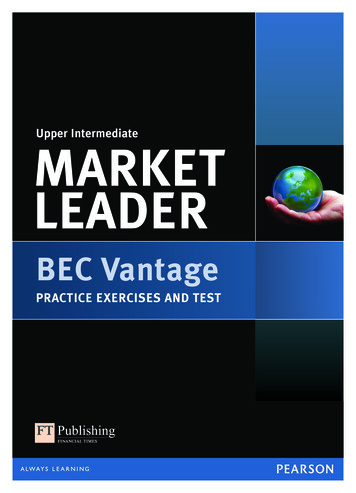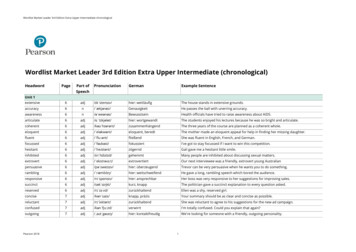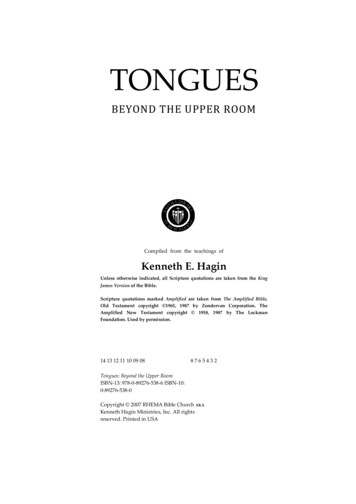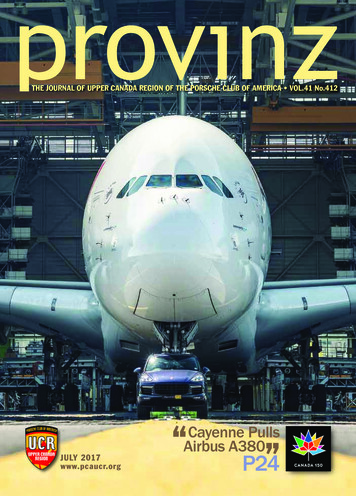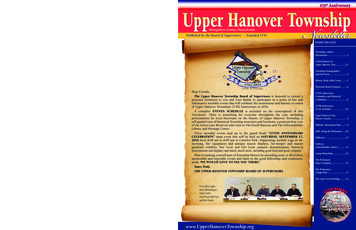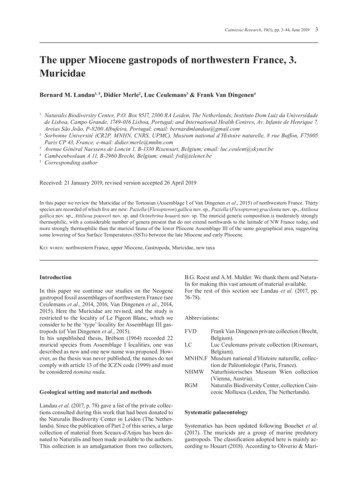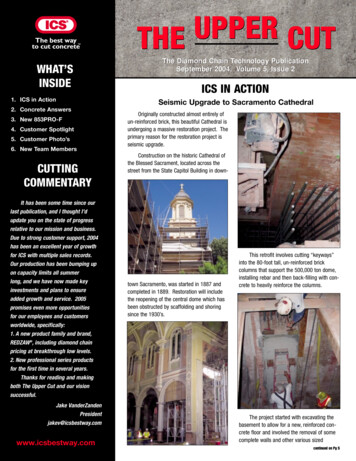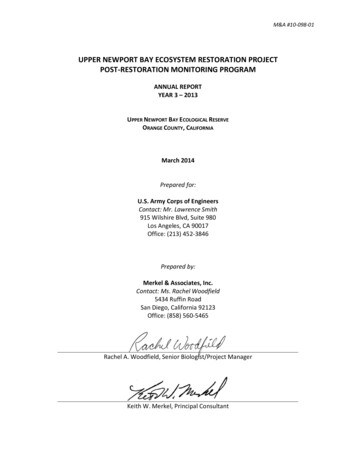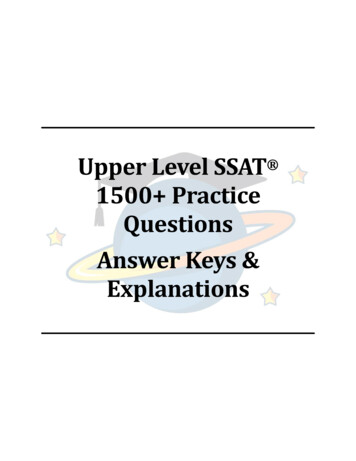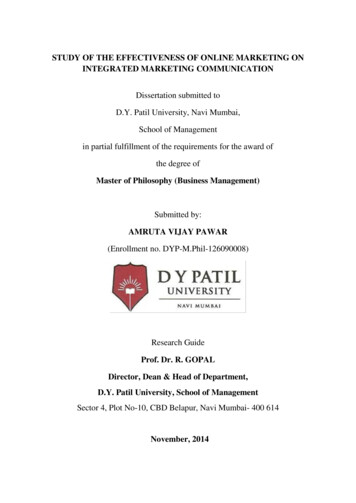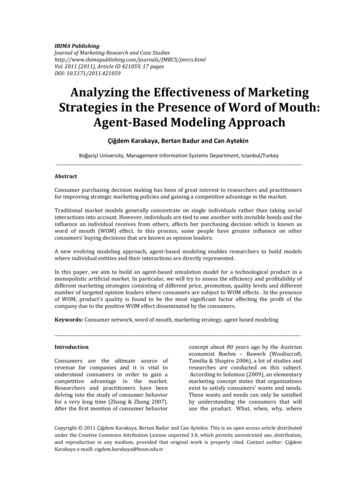
Transcription
International Journal of Health Sciences and ResearchVol.10; Issue: 5; May 2020Website: www.ijhsr.orgISSN: 2249-9571Original Research ArticleEffectiveness of Upper Extremity ProprioceptiveTraining on Reaction Time in Table Tennis PlayersChaitrali Bokil1, Richa Bisen2, Khyati Kalra31B.P.Th, SKN College of Physiotherapy, Pune, IndiaMPT in Orthopaedics and Manual Therapy, Assistant Professor, Electrotherapy and Electro diagnosisDepartment, SKN College of Physiotherapy, Pune, India3Assistant Professor cum Statistician, Department of Community Medicine, SKN Medical College & GeneralHospital, Pune, India2Corresponding Author: Chaitrali BokilABSTRACTBackground: Table tennis is a dynamic sport and is known to be one of the fastest ball games. It hasbeen proven that table tennis requires a short reaction time for success but there is a lack of evidenceon the different types of exercises that can improve reaction time in table tennis players.Objective: To study the effectiveness of upper extremity proprioceptive training on reaction time intable tennis players.Methods: 34 Table tennis players, both males and females in the age group of 7-15 were included inthe study. They were divided into two groups: Control Group (n 17) and Experimental Group (n 17)by lottery method. The reaction time of all the players was measured using the ruler drop test. Thecontrol group underwent a conventional training whereas the experimental group underwent anadditional proprioception training along with conventional training for 6 weeks. The reaction times ofthe players were measured again at the end of 6 weeks.Results: When compared within the group, the reaction time did not show a significant statisticaldifference in the Control group (p 0.05) whereas the reaction time significantly decreased in theexperimental group (p 0.05). When compared between the groups, reaction time showed a significantstatistical difference between the Control and Experimental group (p 0.05) indicating thatExperimental group produced a significantly shorter reaction time than the Control group at the end of6 weeks.Conclusion: This study shows that upper extremity proprioceptive training along with conventionaltraining helps to improve reaction time in table tennis players.Keywords: Table tennis, reaction time, proprioceptive training, ruler drop testINTRODUCTIONReaction Time (RT) is defined astime between the application of a stimulus& the body’s response to the stimulus.Reaction Time can be divided into 3 basictypes: [1]1) Simple Reaction Time (1 stimulus1 response)2) Choice Reaction Time (multiple stimulimultiple responses)3) Recognition Reaction Time (multiplestimulionly one will get response)In simple words, Reaction Time is ameasure of how long it takes to initiate andcomplete an intended movement.Proprioception is defined as thebody’s sense of position and motion, whichincludes body segment static position,displacement, velocity, acceleration, andmuscular sense of force and effort.Proprioception is a subsystem of thesomatosensory system which also includestouch, pain and temperature sense from theskin and musculoskeletal structures. [2]Proprioceptors are sensory endings thatInternational Journal of Health Sciences and Research (www.ijhsr.org)Vol.10; Issue: 5; May 202034
Chaitrali Bokil et.al. Effectiveness of upper extremity proprioceptive training on reaction time in table tennisplayersderive various stimuli in response tomechanical deformation. These stimuli areconverted into electrical impulses and sentto the brain where they are transformed intorelative position and movement parameters.[3]The integrated sensory input from theseproprioceptors at multiple joints creates asystem for the purpose of accurate sensingand determination of limb position andmovements in both open-chain and closedchain activities.Sport is referred to as the ability ofdemonstrating athletic performance in aconstant way. Sports practitioners andresearchers are in constant search of newerand more efficient training methods toachieve success in modern sports requiringever-increasing levels of peak physical andmental conditioning. [4]Reaction Time is one of theimportant factors that leads to success insporting competitions. [5] RT can beinfluenced by various factors like gender,age, physical activity, physical fitness,training and fatigue. Based on these, it hasbeen proven that RT is shorter in athletes ascompared to non-athletes. [6] However evenamong athletes, RT is not caused byperformance but can be improved withtraining. [5,7]Proprioception is an importantsensorimotor function for all mobilityactions. [8-10] Proprioception plays animportant role in sports and contributesgreatly to the performance of athletes.Proprioception Training is defined as aseries of exercises or situations that willproduce a reaction by the nervous system inresponse to an external stimulus. [9] Thenoted dependency between sportingexcellence and proprioceptive abilitysuggests that Proprioceptive training shouldbe incorporated in sports training programs.Studies show a positive effect ofLower Limb proprioception training on RTmeasured by the Newtest 1000 device in[11]normal non-athletic individuals.However, there is a lack of evidence ofstudies on the effect of Upper Extremityproprioception training on RT.Most sports, especially racket sportsrequire good RT for good performance. Dueto lack of evidence, it is suggested thatstudies should be conducted to study theeffect of Proprioception Training on RT indifferent sports branches and in differentage groups. [11]Table Tennis (TT) is a dynamicsport. TT being one of the fastest ballgames, is characterised by perceptualuncertainty and time pressure and hencerequires a short RT for success. [12] RT canbe improved by exercises. [5,7] However,there is lack of evidence on the differenttypes of exercises that can be used toimprove the reaction time in TT players.Table Tennis is a sport in which successdepends on many interconnected factorswith motor co-ordination abilities indicatedas the most important. [13] Studies haveshownthesignificanceofmotor[14,15]coordination in table tennis.However,little research has been done on thesignificance of proprioception in tabletennis where the role of features like sensingthe ball and reacting in time are veryimportant. [16] Hence the lack of evidenceshowed the need of studying the effect ofProprioceptive Training on reaction time intable tennis players.In this study, we studied the Effectsof Upper extremity proprioceptive trainingon reaction time in table tennis players.Reaction time was assessed using the rulerdrop test.METHODOLOGYObjective: To study the effectiveness ofupper extremity proprioceptive training onreaction time in table tennis players.StudyDesign:Apretest-posttestexperimental group design was selected fortesting the hypothesis.Study Population: 34 Novice district leveltable tennis players from Pune were studied.Both males and females in the age group of7-15 receiving at least 1 year of regulartable tennis training were included in thestudy. Elite national level players andplayers with any previous injuries and/orInternational Journal of Health Sciences and Research (www.ijhsr.org)Vol.10; Issue: 5; May 202035
Chaitrali Bokil et.al. Effectiveness of upper extremity proprioceptive training on reaction time in table tennisplayersany other medical conditions or healthproblems were excluded from the study.Procedure: The participants of the studywere divided into 2 groups - Control groupand Experimental group by using the lotterymethod. Both the groups underwent a pretest where RT of the participants wasmeasured using the Ruler Drop Test. [17,18]After the pre-test, participants of both thegroups were given conventional training andthe participants of Experimental group weregivenadditionalUpperextremityproprioception training (Table 1) for aperiod of 6 weeks (4 days/week). After theProprioception Training, RT of participantsof both groups was measured again at theend of 6 weeks.Measurement of reaction time: In thisstudy, RT was measured using the rulerdrop test. The ruler drop test was chosen asthe tool of assessment as it is easy toadminister, requires minimal assistance, ischeap requiring only materials like astandard ruler, pen and paper and has amoderate to good reliability and validity.[17,18]The test was explained and demonstrated tothe participants. The ruler was held by theresearcher between the outstretched indexfinger and thumb of the participant’sdominant hand so that the top of theparticipant’s thumb was level with the zerocentimetre line on the ruler.ExerciseRhythmic stabilizationQuadrupedKneel push-upProne on elbowsPush upFull push up feet elevatedHands on wobble boardHands on bosu ballElbows on gym ballHands on gym ballThe researcher instructed the participant tocatch the ruler as soon as possible after ithad been released.The researcher recorded the distancebetween the bottom of the ruler and the topof the participant’s thumb where the rulerhas been caught.Two trials were given to each participant.[19]Three readings were taken from eachparticipant and the mean was calculated asthe RT of that participant.Reaction time was calculated using theformula:t sqrt (2d/g)t reaction time (in seconds)d the distance at which the ruler wascaught (in metres)g force of acceleration of gravity (9.8m/s2)Exercise Protocol:Conventionaltraining:Conventionaltraining was given to both Control andExperimental groups. It included lower limbstrengthening exercises, core strengtheningexercises and agility training exercises.Proprioception training: Proprioceptiontraining was given only to the Experimentalgroup. The following exercises were givenas a part of upper extremity proprioceptivetraining. [20] (Table 1)Table 1: Proprioception training protocolWeek 1Week 2Week 3Week 430 sec hold 1 min hold2 min hold30 sec hold 1 min hold2 min hold30 sec hold 1 min hold2 min hold30 sec hold 1 min hold2 min hold30 sec hold 1 min hold30 sec hold 1 min hold30 sec hold30 sec holdRESULTSIn this study 34 Table Tennisplayers, 17 in each group were studied. Thedata was analysed using the Epi infosoftware with 95% confidence and the levelof significance at p 0.05. The ReactionTime was compared using parametric tests,Week 52 min hold2 min hold1 min hold1 min hold1 min holdWeek 62 min hold2 min hold2 min hold1 min holdthe unpaired and paired t-tests. TheReaction time within the groups (pre-testand post-test) was analysed using the Pairedt-test. The pre and post-test Reaction timebetween the groups (Control Group andExperimental Group) was analysed usingthe unpaired t-test.International Journal of Health Sciences and Research (www.ijhsr.org)Vol.10; Issue: 5; May 202036
Chaitrali Bokil et.al. Effectiveness of upper extremity proprioceptive training on reaction time in table tennisplayersTable 2: Within group analysisGroupControl GroupExperimental Group Pre-test mean S.D.0.137 0.0160.138 0.017When the results were compared (Table2), RT of the Control Group did notshowanysignificantstatisticaldifference (p 0.05) whereas, RT of tdifference(p 0.05).The post-test RT of the ExperimentalGroup was significantly shorter whencompared to its pre-test values.(GRAPH 1)Table 3: Between Group analysisControl GroupExperimental GrouppPre-testmean S.D.0.137 0.0160.138 0.017(p 0.05)Post-testmean S.D.0.137 0.0130.125 0.017p 0.05When the results were compared(Table 3), pre-test RT did not show anysignificant statistical difference between theControl Group and the Experimental Group(p 0.05). This signifies that the baseline ofreaction time in both groups was matched.When the post-test results were compared,RT showed a statistically significantdifference (p 0.05). Experimental Groupreported a significantly lower reaction timethan Control Group when compared at theend of 6 weeks. (GRAPH 2)Post-test mean S.D.0.137 0.0130.125 0.017pp 0.05p 0.05DISCUSSIONThis study was conducted to find outthe effectiveness of upper extremityproprioception training on reaction time intable tennis players. The control groupunderwent a conventional training whereasthe experimental group received upperextremity proprioceptive training in additionto the conventional training.As per the results, the baselines werematched as the pre-test RT did not show anysignificant statistical (p 0.05) differencebetween the Control Group and theExperimental Group. According to research,RT is extremely important in sports inwhich the movements of the athletes areconditioned with the movements of the ballor with the actions of the opponent. In manyfast movement sports, the success dependson the speed of the athlete in deciding thecounter movements and the speed of thereaction. [21]Another study suggests that TableTennis being one of the fastest ball games,is characterised by perceptual uncertaintyand time pressure and hence requires a shortreaction time for success. [12]Many studies suggest that RT can beimproved by different types of trainingmethods. [6,12,22,23]According to another study,proprioception plays an important role insports and contributes greatly to theperformance of athletes. [9]The results of this study show asignificant statistical difference between thepre-test and post-test RT of the experimentalgroup after 6 weeks of upper extremityproprioception training. This is inaccordance with many studies which provedthat proprioception is an importantsensorimotor function for all mobilityactions. [8,10] Another study stated that theimprovement in reaction time may beassociated with the development in theprocess skills of the sensory-motorInternational Journal of Health Sciences and Research (www.ijhsr.org)Vol.10; Issue: 5; May 202037
Chaitrali Bokil et.al. Effectiveness of upper extremity proprioceptive training on reaction time in table tennisplayersperformance and central neural system dueto the training. [24]The results of the study showsignificant stati
drop test. The ruler drop test was chosen as the tool of assessment as it is easy to administer, requires minimal assistance, is cheap requiring only materials like a standard ruler, pen and paper and has a moderate to good reliability and validity. [17,18] The test was explained and demonstrated to the participants. The ruler was held by theAuthor: Chaitrali Bokil, Richa Bisen, Khyati KalraPublish Year: 2020

